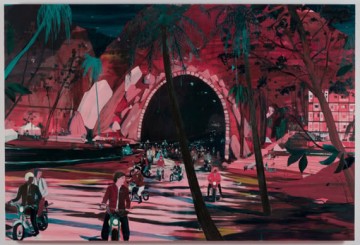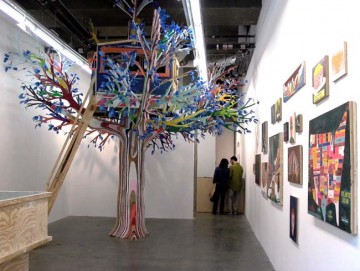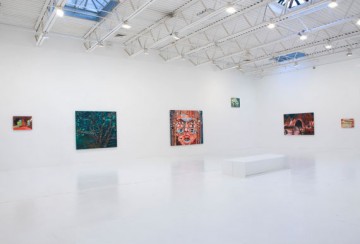by Matthew Newton and Jeffrey Augustine Songco
First, Matthew interviews Hunter College alum Jules de Balincourt on the occasion of his solo exhibition at Deitch Projects, followed by Jeffrey’s look at what his peers are planning to do after graduating from the San Francisco Art Institute.
Matthew Newton, “The Continuing Education of Jules de Balincourt”

Jules de Balincourt in his Bushwick studio following his solo exhibition opening at Deitch Projects in SoHo
In discussing the topic of “life after graduation,” it is important for me to call it “life after graduation from Hunter College.” The personality of this school is so different from others I’ve encountered that the qualification seems necessary. As compared to our many high-profile private and Ivy League neighbors, Hunter is the rugged, under-funded, scrappy underdog; a public school pulling out surprising back-door success stories, of which Jules de Balincourt’s is one of our recent favorites.
Jules has the “life after graduation” story that most MFA hopefuls privately expect, and yet only a tiny percentage actually experience. It’s a narrative that pretty much any young artist would want: arrive at school, start making work, get noticed by an up-and-coming gallerist, have a roundly loved solo exhibition (or two), get glowing reviews from important art critics, sell a lot of art, buy a big studio and keep working. And after all of that, graduate with your MFA. Jules’s arc from just another kid in Brooklyn making art to having important exhibitions worldwide is as sharp as it is unusual.
As a current Hunter student wondering how to stitch together my own career, I sat down with Jules on the occasion of his solo show Premonitions at Deitch Projects — his first since leaving Zach Feuer Gallery and the second-to-last exhibition ever at Jeffrey Deitch’s iconic SoHo gallery — to discuss his time at Hunter, the years following, and to track the circumstances that contributed to his enviable rise.

Jules de Balincourt, "Out of the Darkness and Into the Light," 2009-2010. Oil and acrylic on wood panel, 80.25 x 70.25 inches.
Jules began his description of Hunter with a story:
“One day, Tim (the MFA building coordinator) called me into his office and showed me a list of names. It was all of my friends and my girlfriend at the time and I thought some curator wanted to put us all in a show. It turns out that it was a list of people who had been caught sleeping in the building.”
If Jules needed a good night’s sleep, it wasn’t surprising. After finishing an undergrad ceramics degree at the California College of the Arts, he “hustled and pushed [his] own work,” landing two exhibitions at galleries in San Francisco and Venice, CA. But feeling constrained by the small size of San Francisco’s art community, he moved to New York discovering the opposite problem of a huge “impenetrable club.” A year after arriving in NYC and a week after September 11th, Jules started at Hunter, the only school he had applied to, planning to transition from ceramics to painting. “I applied in ceramics because I knew there would be like twenty ceramics applicants compared to 400 painters.”
Jules’s change in media was one thing, but the larger social upheaval and political climate brought on by 9/11 also provided a framework and key motivation for his early work. In addition, his impression of New York’s art world diminished through his day job as an art handler. Going to the homes of superstars like Jasper Johns and constantly handling important works, he cites that time as a crucial part of his early education in New York, simplifying its complexity and giving perspective on its players. In fact, most of the events and lessons that were most important to him were not part of the prescribed educational program. When asked what was important about his time at Hunter, he references lessons in theory, a couple of professors, but mostly refers to the community of friends he still has today. “I’ve known some of those people now for ten years. We know each other’s work and we’ve seen each other grow.”
Whatever the value of his education, the value of his studio practice was undeniable. “I went to the studio everyday. I would go to my job and then have a second day from 5 until midnight. The studio building was an oasis for me.” He was diligent and it paid off sooner than expected when Zach Feuer saw his work at Jules’s very first Hunter Open Studios. It took another year before Feuer gave him his first show, but even that timeline was blistering compared to other students and most of the faculty. From this point on, Jules’s “life before graduation” blurs into his “life after graduation.” When I voiced my surprise that he even stayed on to finish his degree, he responded, “well, I didn’t have a golden ticket. Plus, I was still a kid and didn’t know what it meant to have a full page review in the Village Voice by Jerry Saltz or a write-up by Roberta Smith in the New York Times.” Also, Hunter’s flexible programming allowed him to draw out his time there to four years, instead of the two that most programs allow. That allowed for the nurturing environment of grad school to continue along with the heightened attention.
But with early exposure to the market and to well-known critics, I wondered if it was hard for Jules to continue experimenting in his work the way that students are able to in graduate school. He acknowledged that it’s a challenge and added, “one critic will think a work is your best and another will think it’s your worst. At some point you have to remember that you have a vision and certain people believe in it, they’ve put their faith in you and you have to move forward.” Jules also began to see his work categorized very narrowly as primitivist-influenced political art. Desiring a fresh context for his work, he made the decisive and responsive decision to move to Berlin for a year, detaching himself from America and its political environment. And his work did change, especially following Obama’s election, to what he calls an “inner gaze” as different from an outward critique. His current show at Deitch Projects represents this new sensibility.
Overall, my impression from speaking with Jules is that his time in a ticketed educational program is difficult to distinguish from his own ambitions and personal trajectory. In fact, the delineation feels mostly irrelevant. School seems to be subsumed within a larger personal vision. He has a fascinating way of leaning on the institutions around him but never allowing them to stagnate his motivation and discarding their rules when necessary. I believe that’s an important lesson for any art graduate student, to take your education seriously but always have a vision for yourself that is beyond the walls of the school. Most palpably, I see Jules’s example as full of individualistic and imaginative purpose matched with an unfettering diligence to realize his objectives. Those aren’t qualities that often come to mind when describing the typical art student, but ones that do describe a ripe setting for a life of making art.
(Jules de Balincourt’s solo exhibition, Premonitions, continues at Deitch Projects, 18 Wooster Street, New York, through April 24. A special thank you to Tim Laun for arranging the interview with Jules.)
Jeffrey Augustine Songco
I’m not graduating until May 2011, so unless I can predict the future, my section of this blog post is preparing itself to be somewhat ridiculous. As Vency touched upon in her interview with me from two weeks ago, my community at San Francisco Art Institute is “small and relationships are formed from day-to-day interaction.” My relationships with my classmates are fabulous—whether lunch in the student lounge or slumber parties on Friday night—so much so that I find it appropriate to include their voices in this topic of Life After Graduation.
Art Fag City’s Paddy Johnson recently wrote, “tis the Open Studio, MFA Thesis exhibition season.” Here at SFAI, the festivities started last week with year-end reviews, followed by the first ever SFAI Graduate Open Studios, which then continues into finals week, and is finally topped off by the MFA Thesis Exhibition. Throughout all this hoopla, I sent an email out to my buddies asking them to share a few words about post-MFA plans. For my first-year classmates, I asked them for Summer 2010 plans.
As the co-chair of the Legion of Graduate Students, a.k.a. LOGS, I’ll be congratulating the graduating students next month with applause, handshakes, high-fives, and requests to clean out their studios in a timely fashion. You don’t have to go home, but you can’t stay here. Just what will they all do after two years of exposure to the “profound understanding of the conditions in which art is produced”?
Stephen Shearer’s got his plans locked down. “Upon graduation and thereafter, I will continue my thesis work uninterrupted,” he says. He’s secured a few performance spaces around the country to present his non-traditional media. “After graduation,” writes Cascade Wilhelm, “I plan to most immediately begin filming a movie that Robin Griswold and I have co-wrote, will co-direct, produce and that I will act in.” Carrie Elzey will be applying to “many fine” residency programs. It’s grand to read that MFA’ers will continue producing after graduation, but I’m interested in drama, so let’s see where it gets a little shaky.
After receiving an undergraduate degree in English, Jenny Odell is realigning herself with writing. “I don’t really have any intention of becoming a gallery artist, or applying for any (fine art) residencies, or doing the whole grant-writing thing. Ideally I would find a job that involved writing or design for a company/organization that isn’t evil in some way (so preferably not advertising!).” Christina Corfield will be “furiously rustling around the Internet until I find something that pays the rent. I just can’t do any more unpaid internships – not in this city!” Also vocal about rent money is Marta Spurgeon. “I already have a part-time teaching job lined up doing a class once a week. That, however, is not going to pay my rent. It probably won’t even pay my bar tabs. So, I was thinking of getting some temp work through staffing agencies and possibly doing some contract work in the field I was in before, design planning. And probably some freelance photography, too.” Finally, Megan Wynne, accompanied by her husband Blade, delivers the 11 o’clock number titled, Moving in with the Folks. “We would like a break from paying rent. They will most likely feed us as well. I don’t really want to stay around here because I have a mortal fear of earthquakes, and I feel like the job market here is too competitive. On one level, its terrible and terribly embarrassing to move back in with one’s parents as a married couple in their early 30s, but then again I must remind myself that we are both artists, and this career choice is crazy and not normal anyway.”
For my first-year classmates, the summer is our oyster: one really expensive appetizer. “This summer is absurd,” writes Massimo Pacchione. “Since it is impossible to live in San Francisco without making money, I had to find a job that paid me enough to live without being too overbearing or difficult. So I’m working at a YMCA. Yes, a YMCA.” Cristina Victor decided to travel and write and Kathryn Williamson will continue to work in the audio/video facilities at school. My MA buddy Pam Campanaro “will focus around research for my thesis project for my continuing year as an Exhibition Museum Studies major at SFAI.”
Both life after graduation and summer between first and second years can all be summed up by Fiamma Montezemolo: “Jeffrey…if I knew it would be marvelous!!!!!!!” Note the number of exclamation marks.
Ah yes, life continues after school! Other than working on my thesis for 2011 and planning my inclusion into The Generational 2012, Whitney Biennial 2014, and Venice Biennale 2023, I thought I should focus more on the upcoming summer. Some highlights: I can retain my studio space at SFAI for production, I’ll continuing my gig as a prairie dog for Art21 Blog, and I’ll dance the day away at San Francisco’s Pride Parade. For more summer to-do’s, I reached out to Bill Powhida for some pointers. He advised,
“I think if you’re looking for something specific; get out and look at art through the spring/early summer. See what the competition is doing. Maybe also not spend as much time getting f***ed up during the summer. Oh, practice writing a couple of art reviews. It might help you write more critically about your own work.”
With the final weeks of school approaching and much planning to attend to, I’ll end my part of this post with the following saying (maybe by Mark Twain): “The coldest winter I ever spent was a summer in San Francisco.”
Matthew Newton is an artist and attends Hunter College’s Studio Art MFA program in Manhattan. His work includes painting, photography, writing, video, sculpture, and installation. He lives in New York City with his wife and daughter.
Jeffrey Augustine Songco is a first-year M.F.A. candidate in New Genres at the San Francisco Art Institute. Born and raised in New Jersey, he spent his childhood dancing with New Jersey Ballet and performing at Paper Mill Playhouse. In 2005, he received his B.F.A. in Art from Carnegie Mellon University.








Pingback: E-Journal #4: Making Art After Graduation | ART 450 Senior Seminar